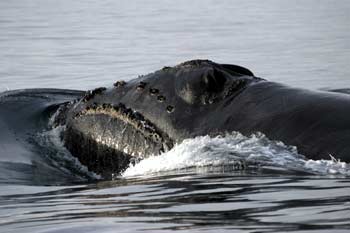 August 01, 2007
"We collaborate internationally with whale researchers," said Dr. Phil Clapham of NOAA's Alaska Fisheries Science Center, who will be the scientific lead on the expedition. "We have worked with the international experts participating in this expedition for some time. Whales travel the oceans: science is best served when information, techniques and skills of whale research are shared internationally." The first leg of the Bering Sea survey, on the Oscar Dyson, will last for two weeks, to be followed by a second two-week leg aboard a chartered fishing vessel. The Oscar Dyson is the first in a series of new NOAA vessels built to meet international standards as acoustically quiet ships. The quieting technology allows the Oscar Dyson to track marine mammals and fish with very little or no disturbance of the species being studied. The survey is funded by the U.S. Mineral Management Service, and is part of a four-year project to assess seasonal distribution, relative abundance and movement patterns of right whales in and adjacent to the North Aleutian Basin area of proposed oil and gas lease sales, and to characterize right whale habitat, foraging behavior, health, and prey distribution. Scientists will place satellite-monitored radio tags on individual right whales as well as studying the population with aerial and shipboard surveys and year-round acoustic monitoring. Scientists will add photo-identifications and biopsy samples to the existing databases for this population for further analysis of individual movements, population structure and genetics. Biopsy samples will also be used to find out about whale diet and contaminant burdens. The specific objectives for the 2007 field work are:
Right whales reach more than 60 feet in length and 100 tons in weight feeding exclusively on plankton. They were heavily hunted during the 19th and early 20th centuries and were already depleted by the time international protections were put in place in 1935. Despite this protection, the former Soviet Union killed an additional 372 right whales in the Gulf of Alaska and Bering Sea in the 1960s, a catch which likely represented the bulk of the remaining population. Today, eastern North Pacific right whales are probably the most endangered stock of whales in the world, and are believed to number fewer than 100 individuals. The right whales in the eastern North Pacific are regarded as a separate stock from that in the western North Pacific. Relatively little is known regarding current right whale distribution in the southeastern Bering Sea, and scientists do not know where these whales spend the winter. Modern sightings of right whales confirm that the southeastern Bering Sea remains an important area for right whales, and a portion of this region was designated as critical right whale habitat by NOAA Fisheries Service in 2006. Moored hydrophones in the southeastern Bering Sea have shown that right whales probably occur in this region from May through October with the highest rate of detected calls in September. NOAA Ship Oscar Dyson was launched at VT Halter Marine, in Pascagoula, Mississippi on October 17, 2003, and was commissioned May 28, 2005 in Kodiak, Alaska. The Oscar Dyson is the first in a series of new fisheries survey ships to be built by NOAA. Named for the late Alaskan fisherman and fisheries industry leader, Oscar Dyson, the ship is one of the most technologically advanced fisheries survey vessels in the world. The ship is home-ported in Mr. Dyson's home town of Kodiak.
Source of News:
Publish A Letter in SitNews Read Letters/Opinions
|
||
